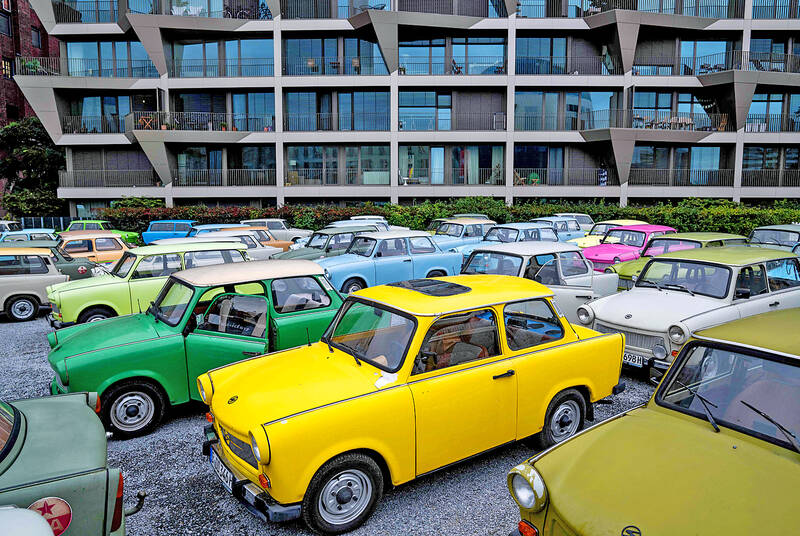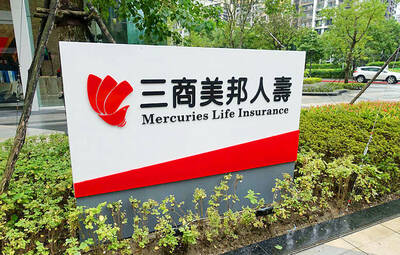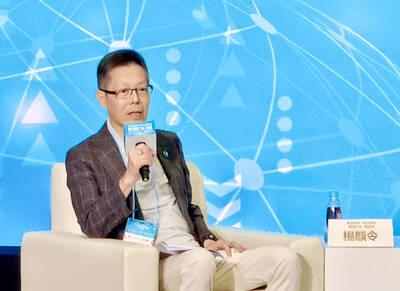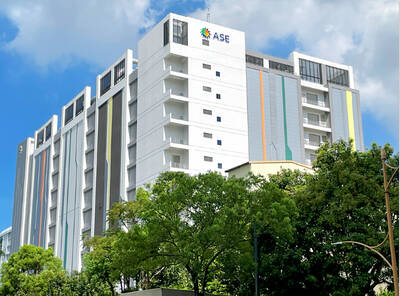With its boxy design, cramped interior and notorious clouds of blue smoke billowing from its exhaust, the Trabant is often referred to as the worst car ever made. Howeber, somehow the plucky East German vehicle has refused to die out, with a dedicated group of enthusiasts still devoted to keeping refurbished models on the road.
As Germany celebrated 35 years of reunification on Friday, the number of so-called Trabis on the streets was actually on the rise as the old rattletraps gain a new legion of fans. There are about 40,800 Trabis registered in Germany today, according to the German Federal Motor Transport Authority — compared with about 33,000 just 10 years ago.
Glenn Kuschan, 58, counts several Trabant owners among the customers at his car repair shop south of Berlin.

Photo: AFP
They include “all sorts,” Kuschan said, from “older people who grew up with [Trabis] to young people who really want an original vehicle.”
Kuschan is the proud owner of 23 Trabis himself, including a white model that once belonged to his father and has clocked up more than 500,000km.
The Trabi has achieved “cult status” because of its association with German reunification and the fall of the Berlin Wall, he said.
The first Trabis were produced in 1957, three years after the communist East German regime decided to create a car for the people.
The bodywork was made of plastic mixed with paper or cotton fiber to save on steel imports.
The backseat windows did not open and the noisy two-stroke engine sent thick clouds of burnt oil and gasoline into the air.
The car’s top speed of 112kph made it a laughing stock in West Germany, where the likes of BMW and Mercedes owned the road.
However, the car nonetheless became a beloved symbol of everyday life in East Germany, praised for its quirky design and durability.
East Germans would put their name on a list and wait up to 15 years for their Trabant to come off the assembly line in one of three colors — ivory, sky blue or peppermint green.
When the Berlin Wall fell in 1989, many East Germans drove to the border and sat in long queues in their Trabis with the engines spewing out fumes as they waited to cross.
After reunification, many East Germans sold the cars in favor of more sophisticated models, while thousands simply gave them away or abandoned them at the border.
The last Trabant, a candy pink model, was produced in 1991.
Today, visitors to the Trabi Museum in Berlin can browse a collection of 20 of the little cars and even take a Trabant tour through the city.
Participants get to feel the thrill of driving a Trabi themselves as they are guided past some of Berlin’s most famous communist landmarks.
Thomas Schmidt, 49, who works at the museum and as a driver on the tours, said he “practically grew up in a Trabi” and now sees the car as “part of my identity.”
“It’s like a little endurance runner, it can do anything, it’s indestructible,” he said.
“And if it does break, the nice thing is that you can repair everything yourself,” he said, due to the “simple technology.”
“People used to say: If you have a hammer, pliers and some wire, you can get to Leningrad,” he said.

AI BOOST: Although Taiwan’s reliance on Chinese rare earth elements is limited, it could face indirect impacts from supply issues and price volatility, an economist said DBS Bank Ltd (星展銀行) has sharply raised its forecast for Taiwan’s economic growth this year to 5.6 percent, citing stronger-than-expected exports and investment linked to artificial intelligence (AI), as it said that the current momentum could peak soon. The acceleration of the global AI race has fueled a surge in Taiwan’s AI-related capital spending and exports of information and communications technology (ICT) products, which have been key drivers of growth this year. “We have revised our GDP forecast for Taiwan upward to 5.6 percent from 4 percent, an upgrade that mainly reflects stronger-than-expected AI-related exports and investment in the third

Mercuries Life Insurance Co (三商美邦人壽) shares surged to a seven-month high this week after local media reported that E.Sun Financial Holding Co (玉山金控) had outbid CTBC Financial Holding Co (中信金控) in the financially strained insurer’s ongoing sale process. Shares of the mid-sized life insurer climbed 5.8 percent this week to NT$6.72, extending a nearly 18 percent rally over the past month, as investors bet on the likelihood of an impending takeover. The final round of bidding closed on Thursday, marking a critical step in the 32-year-old insurer’s search for a buyer after years of struggling to meet capital adequacy requirements. Local media reports

TECHNOLOGICAL RIVALRY: The artificial intelligence chip competition among multiple players would likely intensify over the next two years, a Quanta official said Quanta Computer Inc (廣達), which makes servers and laptops on a contract basis, yesterday said its shipments of artificial intelligence (AI) servers powered by Nvidia Corp’s GB300 chips have increased steadily since last month, should surpass those of the GB200 models this quarter. The production of GB300 servers has gone much more smoothly than that of the GB200, with shipments projected to increase sharply next month, Quanta executive vice president Mike Yang (楊麒令) said on the sidelines of a technology forum in Taipei. While orders for GB200 servers gradually decrease, the production transition between the two server models has been

ASE Technology Holding Co (日月光投控), the world’s largest integrated circuit (IC) packaging and testing supplier, yesterday announced a strategic collaboration with Analog Devices Inc (ADI), coupled with the signing of a binding memorandum of understanding. Under the agreement, ASE intends to purchase 100 percent shares of Analog Devices Sdn Bhd and acquire its manufacturing facility in Penang, Malaysia, a press release showed. The ADI Penang facility is located in the prime industrial hub of Bayan Lepas, with an area of over 680,000 square feet, it said. In addition, the two sides intend to enter into a long-term supply agreement for ASE to